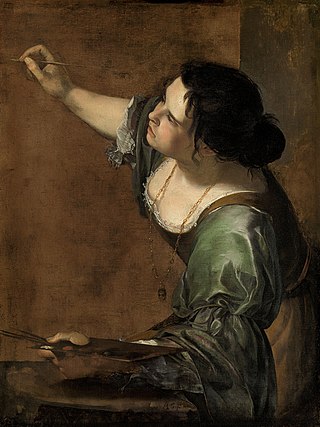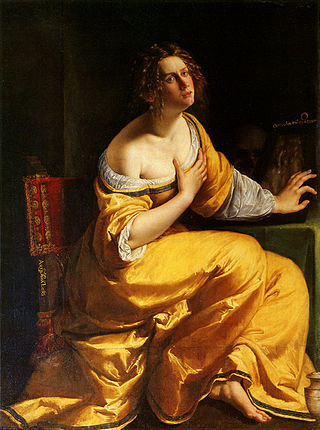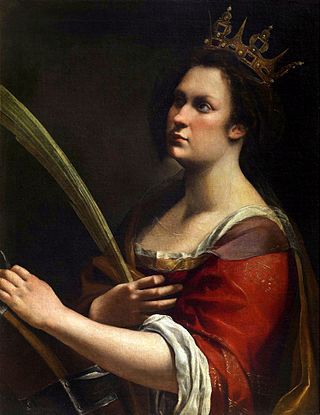
Artemisia Lomi or Artemisia Gentileschi was an Italian Baroque painter. Gentileschi is considered among the most accomplished 17th-century artists, initially working in the style of Caravaggio. She was producing professional work by the age of 15. In an era when women had few opportunities to pursue artistic training or work as professional artists, Gentileschi was the first woman to become a member of the Accademia di Arte del Disegno in Florence and she had an international clientele.

Judith Slaying Holofernes is a painting by the Italian early Baroque artist Artemisia Gentileschi, completed in 1612-13 and now at the Museo Capodimonte, Naples, Italy.

Self-Portrait as the Allegory of Painting, also known as Autoritratto in veste di Pittura or simply La Pittura, was painted by the Italian Baroque artist Artemisia Gentileschi. The oil-on-canvas painting measures 98.6 by 75.2 centimetres and was probably produced during Gentileschi's stay in England between 1638 and 1639. It was in the collection of Charles I and was returned to the Royal Collection at the Restoration (1660) and remains there. In 2015 it was put on display in the "Cumberland Gallery" in Hampton Court Palace.

Susanna and the Elders is a 1610 painting by the Italian Baroque artist Artemisia Gentileschi and is her earliest-known signed and dated work. It was one of Gentileschi's signature works. She painted several variations of the scene in her career. It hangs at Schloss Weißenstein in Pommersfelden, Germany. The work shows a frightened Susanna with two men lurking above her while she is in the bath. The subject matter comes from the deuterocanonical Book of Susanna in the Additions to Daniel. This was a popular scene to paint during the Baroque period.

Esther Before Ahasuerus is a painting by the 17th-century Italian artist Artemisia Gentileschi. It shows the biblical heroine Esther going before Ahasuerus to beg him to spare her people. The painting is now in the Metropolitan Museum of Art in New York, having been donated to the museum by Elinor Dorrance Ingersoll in 1969. It is one of Gentileschi's lesser known works, but her use of lighting, characterization, and style help in successfully portraying Esther as a biblical heroine as well as the main protagonist of the work.
This is an ongoing bibliography of work related to the Italian baroque painter Artemisia Gentileschi.

Self-Portrait as a Lute Player is one of many self-portrait paintings made by the Italian baroque artist Artemisia Gentileschi. It was created between 1615 and 1617 for the Medici family in Florence. Today, it hangs in the Wadsworth Atheneum Museum of Art, Hartford, Connecticut, US. It shows the artist posing as a lute player looking directly at the audience. The painting has symbolism in the headscarf and outfit that portray Gentileschi in a costume that resembles a Romani woman. Self-Portrait as a Lute Player has been interpreted as Gentileschi portraying herself as a knowledgeable musician, a self portrayal as a prostitute, and as a fictive expression of one aspect of her identity.

Judith and Her Maidservant is one of four paintings by the Italian baroque artist Artemisia Gentileschi that depicts the biblical story of Judith and Holofernes. This particular work, executed in about 1623 to 1625, now hangs in the Detroit Institute of Arts. The narrative is taken from the deuterocanonical Book of Judith, in which Judith seduces and then murders the general Holofernes. This precise moment illustrates the maidservant Abra wrapping the severed head in a bag, moments after the murder, while Judith keeps watch. The other three paintings are now shown in the Museo di Capodimonte in Naples, the Palazzo Pitti in Florence, and the Musée de la Castre in Cannes.

Madonna and Child is an early painting by the baroque painter Artemisia Gentileschi. It was painted around 1613, when Artemisia was around 20 years old. It currently hangs in the Galleria Spada in Rome.

Self-Portrait as a Female Martyr, is also known as the Self-Portrait as a Martyr Saint. This painting was created by the Italian female artist, Artemisia Gentileschi. This self-portrait was made around 1615 depicting the artist herself as a martyr. It is one of two paintings by Gentileschi painted with oil on a wood panel. This self-portrait is currently in a private collection in the United States.

Santa Cecilia is an early painting, from c. 1620, by the Baroque painter Artemisia Gentileschi, a painter described as "a grand exception in the history of art - a successful woman painter in an era in which art was dominated by men."

Penitent Magdalene is a 1616–1618 painting by the Italian baroque artist Artemisia Gentileschi. This painting hangs in the Pitti Palace in Florence. The subject is the biblical figure Mary Magdalene, but the painting references another biblical woman, Mary, the sister of Lazarus. This painting was likely painted during Gentileschi's Florentine period.

Saint Catherine of Alexandra is a painting by the Italian Baroque artist Artemisia Gentileschi. It is in the collection of the Uffizi, Florence. Gentileschi likely used the same cartoon or preparatory drawing to create both this painting and the Self-Portrait as Saint Catherine of Alexandria (1615–1617), now in the National Gallery, London.

The Allegory of Painting is an painting from around the 1640s attributed in 1988 to the Italian Baroque artist Artemisia Gentileschi, although more recent research suggests it was painted by an anonymous Neapolitan painter in the mid-17th century. It is now in the Musee de Tesse, Le Mans, France.

Corisca and the Satyr was painted in the 1630s by the Italian artist Artemisia Gentileschi. It currently hangs in a private collection.

Susanna and the Elders is one of several paintings on this theme executed by the Italian baroque artist Artemisia Gentileschi. This version, painted in 1649, hangs in the Moravian Gallery in Brno, Czech Republic. It is signed with Gentileschi's signature and the date on the balustrade on the right.

Lucretia is a painting by the Italian baroque artist Artemisia Gentileschi. It depicts Lucretia, the wife of Roman consul and general Collatinus, at the moment of her suicide. The decision to take her own life was made after she was blackmailed and raped by Sextus Tarquinius, a fellow soldier of Collatinus. It is one of a number of paintings of Gentileschi that focus on virtuous women ill-treated by men.

The Self Portrait of Italian baroque artist Artemisia Gentileschi was painted in the early 1630s. It currently hangs in the Palazzo Barberini, Rome. It is one of many paintings where Gentileschi depicts herself. Beyond self-portraits, her allegorical and religious paintings often featured herself in different guises.
Allegory of Inclination is a 1615-1617 oil on canvas painting by Artemisia Gentileschi on the ceiling of the Galleria in the Casa Buonarroti, in Florence. The painting depicts a young nude female seated in the heavens holding a compass. Her light-colored hair is elaborately styled and she is partially covered by swirling drapery. A star appears above her head.

Saint Januarius in the Amphitheatre at Pozzuoli is a 1635-1637 oil on canvas painting by Artemisia Gentileschi. The work shows the moment that the Christian martyr Januarius and his followers are thrown to a group of wild animals in the amphitheatre in Pozzuoli - however, they lick the saint's feet rather than attacking him and Januarius is unharmed.

















